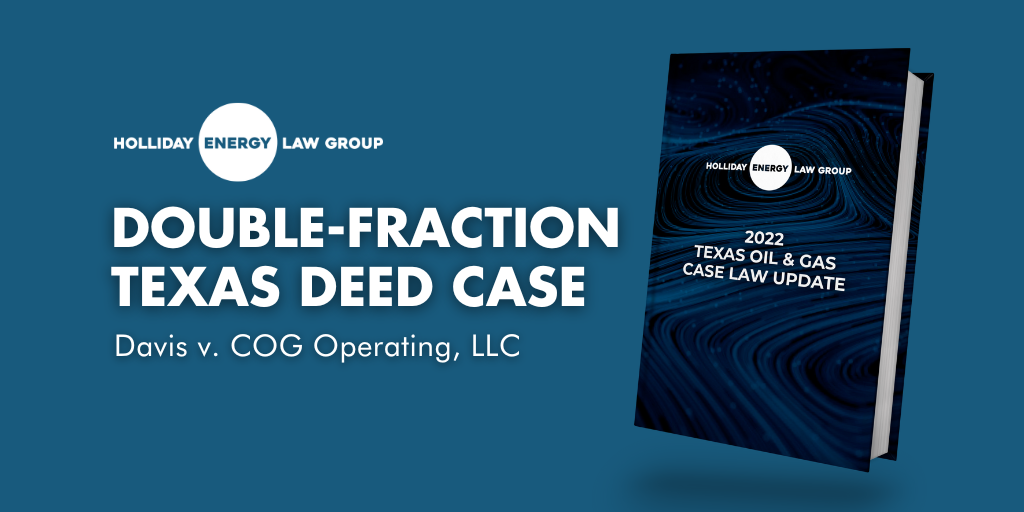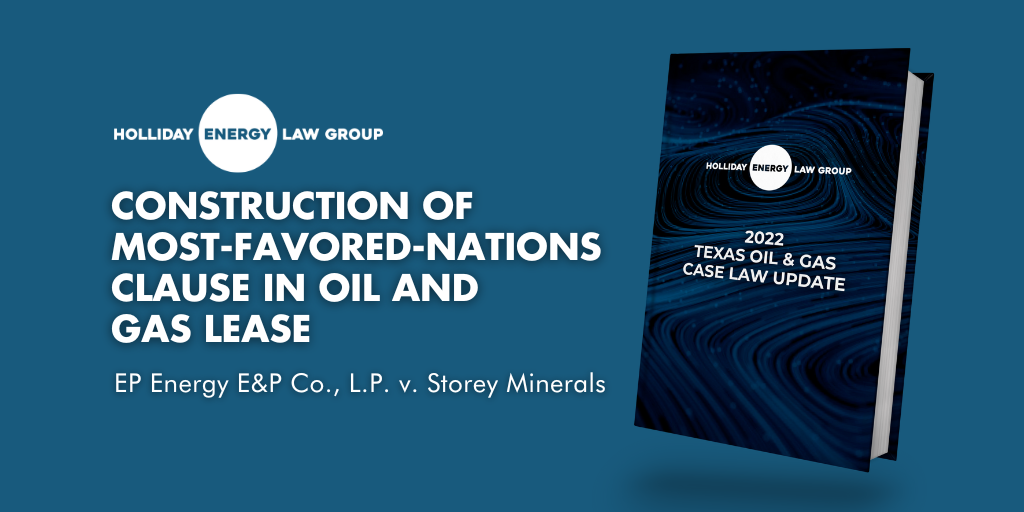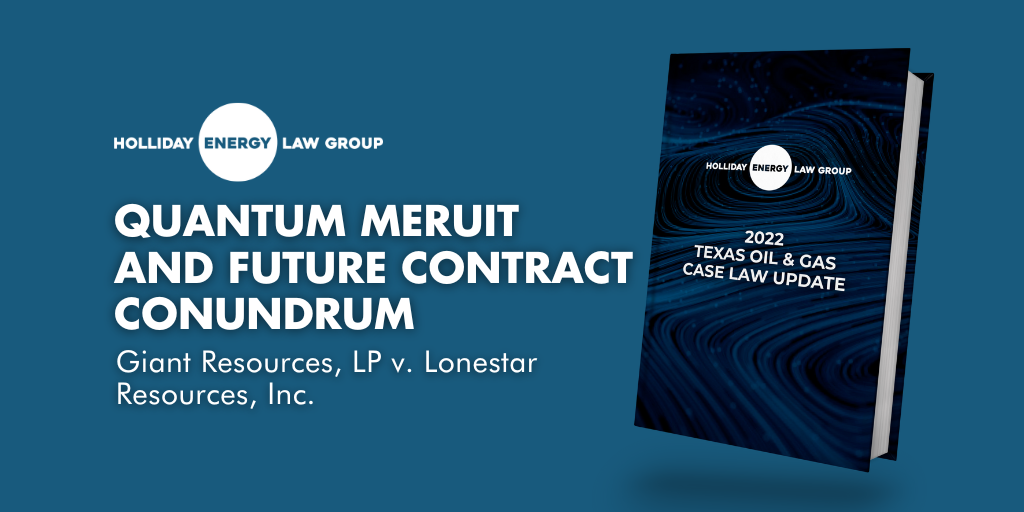Double-Fraction Texas Deed Case

Davis v. COG Operating, LLC, No. 08-20-00205-CV, 2022 WL 17477948 (Tex. App. –Eastland 2022, no pet. h.). Double Fractions.
In Davis v. COG Operating, the Eighth Court of Appeals interpreted a 1926 deed in which the granting clause purported to convey a 1/32 mineral interest and the rest of the document purported to convey 1/4. In holding that the deed unambiguously conveyed a 1/4 mineral interest, the court noted that 1/32 is the product of 1/4 and 1/8 and that 1/8 was the standard royalty reserved under an oil and gas lease at the time the deed was executed. Additionally, the court held that a subsequent 1939 deed that purported to except the same 1/32 mineral interest effectively put the parties on notice of the 1926 conveyance of 1/4 of the mineral estate.
Key Takeaways
- The Supreme Court of Texas has taken judicial notice of the fact that during the 1920’s and 1930’s, oil and gas leases typically provided a 1/8 royalty to the landowner.
- Where an otherwise unambiguous deed from the relevant time period purports to convey a mineral interest using two fractions and one is the product of the other times 1/8, courts are likely to find that the drafters were operating under the estate misconception. Under the misconception, courts sanctioned the multiplication of fractional mineral ownership by 1/8 when lands were subject to active oil and gas leases.
Origin of the Dispute
Andreas Sessler and his wife, Johanna, purchased the entire surface and mineral estate of Section 45 in 1908. In March 1926, the Sesslers signed a mineral lease in favor of F.K. Campbell covering Section 45 (the “Campbell Lease”). Later that year, on November 1, 1926, the Sesslers executed an instrument titled “ROYALTY DEED” (the “1926 Deed”), which conveyed part of their interest in Section 45 to W.H. Haun.
Then, on May 3, 1939, the Sesslers executed an instrument titled “WARRANTY DEED” (the “1939 Deed”), which purported to convey to Dora Roberts the remainder of their interest in Section 45, except for a 1/4 NPRI. The 1939 Deed to Roberts twice mentioned that an interest in the land had previously been conveyed to Haun.
Since the execution of the 1939 Deed, the remaining 3/4 of royalties have been paid to Roberts and her successors, including the relevant Neal appellees. But no royalties have been paid since 1939 to the Sesslers or their heirs or successors.
In 1984, a number of the Sessler descendants (the “Sessler Heirs”) sent, through their attorney, a letter to Saxon Oil, who was at the time the mineral lessee of Section 45. The letter asserted claims to the Sessler NPRI under the 1939 Deed. In three letters from late 1984 and early 1985, Saxon Oil responded, disputing claims by the Sessler Heirs. The Sessler Heirs never pursued legal action regarding the Sessler NPRI after that time.
In 2017 and 2018, some of the Sessler Heirs sold their claimed interest in the Sessler NPRI to James H. Davis d/b/a JD Minerals (the “Sessler Successors”). The Sessler Successors notified COG Operating, LLC (“COG”), lessee of Section 45’s minerals, and the Neals of their claim to part of the Sessler NPRI.
Procedural History
On April 13, 2018, the Sessler Successors filed the underlying lawsuit against the Neals and COG. The Sessler Successors’ first cause of action sought a declaratory judgment asking the trial court to determine the ownership rights under the deeds executed in 2017 and 2018, and to establish the Sesslor Successors as potential third-party beneficiaries under COG’s oil and gas lease from the Neals.
The Sessler Successors’ second cause of action was a trespass-to-try-title claim against the Neals, alleging they “wrongly asserted possession over [the Sessler Successors’] interest” in a portion of the Sessler NPRI. The remaining ten causes of action included conversion, unjust enrichment, money had and received, breach of contract, tortious interference with an existing contract, breach of fiduciary duty, breach of duty of good faith and fair dealing, unpaid royalties, negligence, and conspiracy.
The trial court held hearings on the competing summary judgment motions by the Neals and Sessler Successors on November 18, 2019. On February 27, 2020, the trial court granted summary judgment on all claims in favor of the Neals and denied the Sessler Successors’ motion for summary judgment.
COG’s motion for summary judgment was then heard on August 18, 2020. Days afterwards, the trial court issued a Final Summary Judgment (the “Order”), in which the court reiterated its ruling on the Neals’ and the Sessler Successors’ cross-motions for summary judgment, and further granted summary judgment in favor of COG, rendering a take nothing judgment against the Sessler Successors’ claims against COG. The Sessler Successors appealed.
The Appeal
On appeal, the Sessler Successors raised four issues consisting of a primary issue, followed by three contingent issues. As their primary issue, the Sessler Successors contend they own – under the 1939 Deed – a portion of the Sessler’s NPRI based on well-established principals of deed construction. As a part of that issue, they attack the application of the Duhig doctrine, the presumed-grant theory, and time limitations, which are all grounds relied upon by the Neals and COG to oppose the Sessler Successors’ title claim.
The 1926 Deed
The Texas Eighth Court of Appeals first addressed the confusion surrounding the 1926 Deed to aid in the construction of the 1939 Deed. The court explained that traditionally, the language used to create an interest in the mineral estate – as opposed to merely an interest in the royalties only – is a reference to the oil, gas, and other minerals “in and under” the described land. On the other hand, a royalty is “typically created simply by using the word ‘royalty.’”
In the 1926 Deed, the Sesslers used “in and under” language and the deed does not purport to strip Haun of any of the traditional interests included in the mineral estate. Here, the court of appeals determined that when read as a whole and notwithstanding the title of the deed, the 1926 Deed clearly and unambiguously conveyed an interest in the mineral estate itself, not merely a royalty interest.
Double Fractions
The court next considered the conflicting fractions that appear in the 1926 Deed. The Neals argued that the 1926 Deed effectively conveyed two interests: first, a 1/32 interest in the mineral estate; and second, a 1/4 royalty interest. The court noted that this “two-grant” theory surrounding deeds of this era has been rejected by the Supreme Court of Texas. In the era including the 1920’s and 1930’s, the prevailing landowner’s royalty in oil-and-gas leases would provide for a 1/8 royalty.
In rejecting the Neals’ argument, the court explained that in Concord Oil v. Pennzoil Exploration Co., the Texas Supreme Court held that a deed conveyed a single interest where the opening paragraph of the deed described a 1/96 interest in the “estate” and the second paragraph stated the interest “covers and includes one-twelfth (1/12) of all rentals and royalty of every kind and character.”
The court explained that the 1926 Deed fits the structure and pattern of the deed in Concord Oil. That is, the 1/32 fraction found a single time in the granting clause represents exactly 1/8 of the 1/4 interest used in the rest of the deed to describe the mineral interest conveyed. Thus, the court of appeals determined that the intent of the parties to the 1926 Deed was to convey one interest only: a 1/4 interest in the mineral estate, not two separate interests.
The 1939 Deed
The second paragraph of the 1939 Deed stated that “[i]t is understood, however, that 1/32 of the oil, gas and other minerals has heretofore been conveyed to W.H. Haun, and this conveyance does not include such mineral interests so conveyed.”
The third paragraph to the 1939 Deed stated that “[i]t is further understood and agreed that we [the Sesslers] reserve unto ourselves, our heirs and assigns, one-fourth (1/4) of the 1/8 royalty usually reserved by and to be paid to the land owner in the event of the execution of oil and gas leases, so 1/4 of the 1/8 royalty to be paid to us, our heirs or assigns, if, as and when produced from the above described land, but it is understood that the mineral interest so reserved by and for us is a royalty interest only …”
Here, the court explained that despite the lack of ambiguity, questions of interpretation arise, particularly with regard to the deed’s use of a 1/32 fraction to describe the interest previously conveyed to Haun.
The Sesslers argued that the second paragraph of the 1939 Deed effectively put Roberts on notice of Haun’s pre-existing interest in the mineral estate resulting from the conveyance in the 1926 Deed. Countering, the Neals argued that the parties to the 1939 Deed – the Sesslers and Roberts – intended a literal meaning of the 1/32 fraction and, consequently, that Roberts was not put on notice of the extent of Haun’s ownership.
The court explained that this issue turns on whether the parties to the 1939 Deed were operating under the estate-misconception. If Roberts and the Sesslers were operating under the estate-misconception, Roberts would have understood this paragraph to mean the Sesslers had previously conveyed a 1/4 interest in the minerals to Haun.
The court concluded that the parties were operating under the estate-misconception and provided three reasons. First, the court considered the date of the deed- 1939. This date places the deed during the height of the period when estate-misconception was prevalent. Second, 1/32 is the product of multiplying 1/4 of 1/8. Third, the explicit use of a double fraction in the third paragraph.
The court clarified that neither the date of the deed, the fact that 1/32 is a multiple of 1/8, or the use of a double fraction alone demonstrates that the parties were operating under the estate-misconception. However, viewing the deed as a whole, taking these three indicators together, and harmonizing the deed’s plain language within its applicable context, the court determined that the parties’ intent behind the second paragraph was to place Roberts on notice that the conveyance excluded the 1/4 interest in the mineral estate that had previously been conveyed to Haun.
As for the third paragraph, the court determined that the Sesslers expressly reserved, for themselves and their heirs and successors, a floating 1/4 NPRI in Section 45. Here, the court noted that the third paragraph begins with the phrase, “it is further understood.” The court explained that the use of the word “further” indicates that what is described thereafter is something different from what was described before.
The court then swiftly disposed of the Neals’ attempt to apply the Duhig and presumed grant doctrines, noting they are inapplicable under the facts of this dispute.
Trespass-To-Try-Title
Next, the Neals argued that the Sessler Successors’ trespass-to-try-title claim was barred by the limitations or laches defense. However, the court of appeals disagreed, explaining that while various statutes of limitations, as well as the doctrine of laches may apply to some of the Sessler Successors’ other claims, neither applies to a trespass-to-try-title action where the plaintiffs’ right is based on legal title.
Accordingly, the court of appeals concluded that the trial court erred in granting the Neals several motions for partial summary judgment, while denying the Sessler Successors’ cross motion for partial summary judgment.
The Remaining Issues
In addition to dismissing the trespass-to-try-title claim, the trial court’s order also rendered a take nothing judgment against the other eight claims filed by the Sessler Successors against the Neals. However, the court of appeals noted that the order itself does not explicitly indicate whether such claims were adjudicated based on the trial court’s ruling on the trespass-to-try-title claim, or whether the court rendered judgment on those claims individually based on the merits.
The court explained that the record indicates that the trial court has not considered the merits of the other eight claims against the Neals or the seven against COG. Instead, the trial court rendered judgment on the other eight claims against the Neals simply because it determined the trespass-to-try-title claim and rendered summary judgment on that issue in favor of the Sessler Successors.
Because the court of appeals reversed the trial court on the trespass-to-try-title claim and rendered judgment on that issue in favor of the Sessler Successors, the court remanded the claims ancillary to title to the trial court for disposition.
For a more detailed insight into the 2022 Texas Oil & Gas Case Law Update, download the HELG paper.


